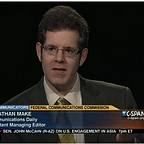Addressing Media-Trust Challenges at Google, Via SPJ
Talking about what technology to use and how to use it to help rebuild trust in news naturally brings to mind a lot of the media industry’s challenges. At a Google News Initiative training event on elections with the Society of Professional Journalists, challenges aplenty were mentioned. More important perhaps for the road ahead, Tuesday’s event focused on some potential solutions. As has been widely noted, much of the technology discussed can also be used for ill means, and the underlying challenging business climate for news-media was partly caused by tech platforms.
This event included Google staffers and others affiliated with the company. True to form and its own advertising, it focused on various “tools” from the company. Some speakers made the case that this is meant to be more of a do-good type initiative than a profit-making one. The company doesn’t make money off these features, noted trainer Nick Whitaker. It’s “important for tech companies to be stepping up” and helping journalists, he said. “We have support across the entire company now, that’s really what the Google News Initative is.”
Speakers working for Google and otherwise noted that boosting lagging public trust in news needs widespread stakeholder support. “Collaboration is key,” Whitaker said. “We can find better solutions together, and that’s kind of the whole idea [of] why we are here today.” Signaling that particular content is trustworthy helps to cut “through some of the misinformation or disinformation out there,” he said. “I think its going to take [several] different strategies.”
News literacy is but one way to address this. Lack of understanding of what’s legitimate and what’s not news-wise doesn’t just affect the young, multiple speakers said. Many people have hard time “discerning between factual and non-factual information,” said Whitaker. “News literacy is a piece of this.”
SPJ President Alex Tarquinio put in a plug for the association’s own training, a project where volunteers visit classrooms. “We take media literacy very seriously,” she said. “This is actually important across all age groups.” Another problem, she said: “I think we take it for granted that non-journalists understand our lingo.”
Verifying images can identify hoaxes, noted SPJ trainer Frank Bi, from Vox Nation. In addition to outright hoaxes, news outlets sometimes are wrong: “We are all humans.” Bi showed the audience of several dozen how to do a reverse image search, which can show when photos are doctored. Once you’re comfortable doing this, “it takes less than a few seconds to verify” images, he noted. Bi also showed how to get information on a photo’s location/metadata to find out where it was taken. This uses images.google.com.
At this and other junctures, some audience members indicated concerns about the privacy implications of the public availability of such data. That’s perhaps another example of how even tools that are helpful to journalists and/or the public have potential downsides.
Attendees also heard about how to accurately use polls in covering politics and how not to fall for biased surveys. It boils down to common sense and basic journalistic tenets — as does fighting fake news. Know the basics about how polls were conducted, what sort of organization did them and when, and how questions were asked of respondents and in what order. “Do they have a dog in the fight or some sort of vested interest in the outcome,” advised Kyley McGeeney of evaluating credibility of an organization that conducted a poll. Are the questions respondents are asked “leading, are they biased in some way?” she said. McGeeney represents the American Association for Public Opinion Research, where in a volunteer capacity she works with media organizations.
Showing a photo of the infamous incorrect newspaper banner headline “Dewey Defeats Truman,” McGeeney said that “we thought this was the biggest dedable in polling, and then 2016 happened,” to much audience laughter. “All of this has led to a bit of a crisis in polling.” She pointed out that national polls correctly anticipated that then-presidential candidate Hillary Clinton would win the popular vote over Donald Trump by 3 percent. Although Clinton did win by that measure by two points, she of course lost the electoral college tally.
Tips for journalists about polling are here. For recaps of photo and video image reverse searches and many other how-tos from today’s session: https://newsinitiative.withgoogle.com/training/. You can read some of highlights of the training: https://twitter.com/makejdm.
